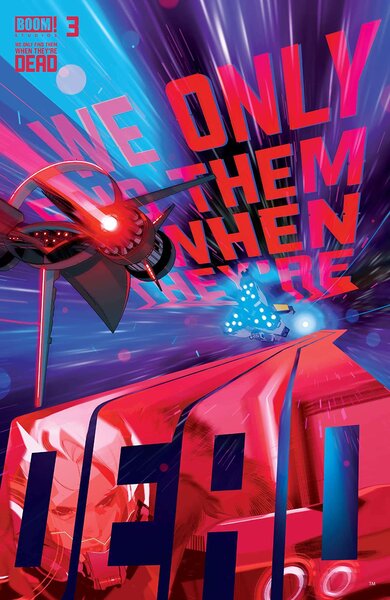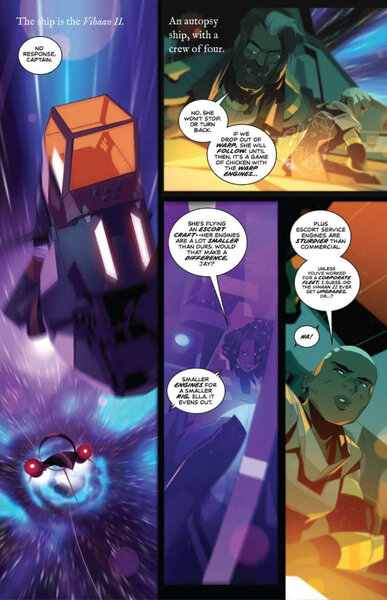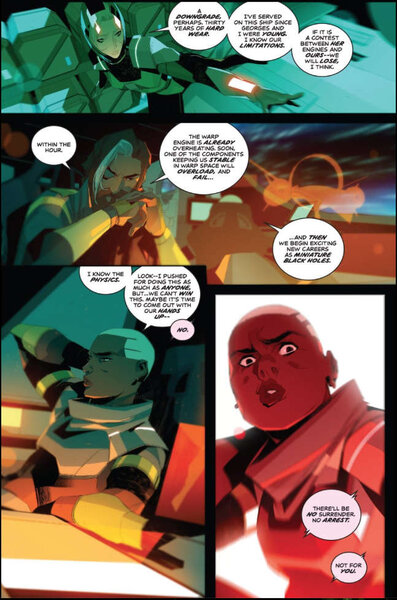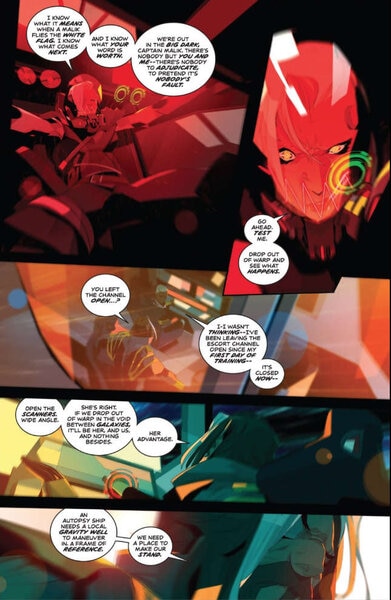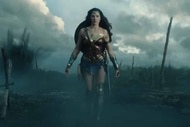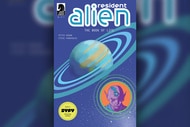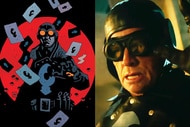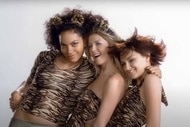Create a free profile to get unlimited access to exclusive videos, sweepstakes, and more!
Indie Comics Spotlight: Kirby-esque space gods are mortal in Al Ewing's 'We Only Find Them When They're Dead'
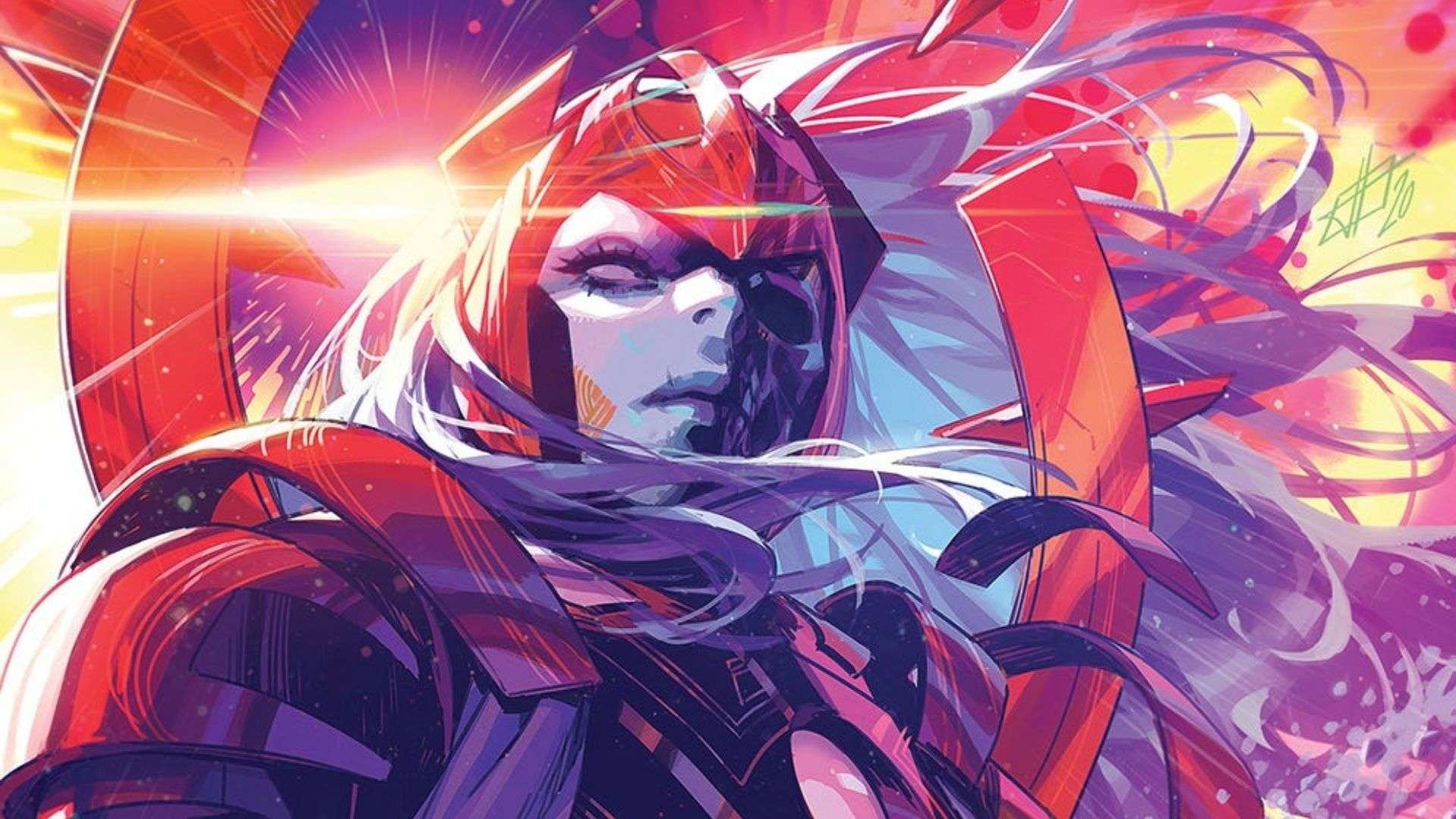
Writer Al Ewing (Ultimates, Immortal Hulk, Guardians of the Galaxy) has been quietly pushing the boundaries of familiar characters in comics over the past few years. His body-horror take on Immortal Hulk was terrifying and transformative. His runs on both Guardians of the Galaxy and Empyre included such intricate worldbuilding and plot development that we can only hope his stories spills over into the MCU. So it’s no wonder that his creator-owned project, the expansive We Only Find Them When They’re Dead (BOOM!), a story about a spaceship and its crew on a quest to find a living god, is just as compelling.
We Only Find Them When They’re Dead doesn't just make the gods accessible — it makes them mortal. In a twist on the classic alien abduction tale, the story follows Captain Georges Malik and his crew aboard the autopsy ship the Vihaan II as they mine the bodies of dead alien “gods” that exist as floating behemoths on the outer edges of space. No one knows where they came from or why the gods seem to be only visible after their demise. In Ultimates and Immortal Hulk, Ewing explored different aspects of the godlike Marvel villain Galactus, known as “Devourer of Worlds." Here, it’s the humans devouring the gods.
Practically speaking, “god meat” is rich in minerals, protein, and water that feeds humans, fetches a high price, and there are plenty of other contractor autopsy ships to compete with. The rules of the hunt are run by the government organization known only as "Control" and enforced by "Agents" who act as judge, jury, and executioner to anyone trying to outsmart the system — and they carry out their duties with deadly accuracy.
Malik, jaded and driven by a traumatic past, is on a quest to encounter a living god. He is hunted by rogue government Agent Paula Richter, whose murderous grudge against the Captain puts the mission and this entire crew in her crosshairs.
Illustrator Simone Di Meo (Mighty Morphin Power Rangers) beautifully captures the vastness of space and his use of light is nothing short of stunning. One part Kirby and one part Gundam, Di Meo’s interpretation of the gods is dynamic and balances well with Ewing’s writing, which often drops you right in the middle of the action. Regularly jumping from flashbacks to the present, Ewing’s contemplative dialogue metaphorically touches on environmentalism, capitalism, and religion without being preachy.
SYFY WIRE spoke with Al Ewing about where this story came from, how he found time to write it, and why he’s attracted to the “man vs. god” concept.
You are still writing Immortal Hulk and Guardians of the Galaxy, and you just wrapped Empyre this summer. Where did you find the time to work on this project?
We had a lot of lead time in the run-up to this, so I got a small head start, and it’s now taken its place in my (admittedly fairly packed) schedule. I’m generally a bit busier than I should be at all times — there’s a lot going on — but weirdly, I tend to write better without much time to vacillate, so it works out. Unless I just jinxed it.
What was the inspiration for We Only Find Them When They’re Dead?
It’s an idea I’ve been carrying around for a while. I think the original image of performing an autopsy on a giant Kirby-esque space god got itself stuck in my head around four years ago or so. I’d rather leave what they represent up to the reader — it’s a very exploratory process for me. It could be that finding a living god represents finding some deeper meaning to things.
I’ve moved from firmly atheist to more agnostic as I’ve gotten older, and I’m noticing a lot of my work deals with religion in some way. I don’t think that’s because of any particular desire for belief, more a fascination with liminality, the sublime, the unknown. I’m always trying to capture that feeling of vast, unknown powers, tap into some kind of primal awe.
Does Earth still exist in this future? And what state is it in if mining god carcasses is our form of survival?
Earth probably still survives, but it’s unimportant. The closest we’ll get is the Inner Worlds — that’s where the mined stuff is going. Earth might be one of those worlds, but it’s one of a collective. As for the state of it — we’re going to get deep into it in book two, but “survival” is a little strong. What’s being mined here is what keeps a certain standard of living ticking over, and as events progress, we’ll see how that changes.
What attracts you to the "man vs. god" concept?
It’s probably that fascination with the sublime. For instance, the parts of the Bible that interest me are those parts where God is an unknowable, capricious presence — the Book of Job is a particular favorite. But I suppose WOFTWTD is more about the capriciousness of humanity — if there was ever an attempt to study or understand these beings, that time has long passed. Now they’re just resources.
We are only three issues in and we have barely left the ship, but this story feels massive in scale. How did you and Simone Di Meo achieve that?
We did leave the ship in flashback — we’ve had a brief glimpse of life on the colony. And we’re going to be spending more time outside ships as we go. But in terms of the scale, it helps that the ship is so connected with the crew, in that it doesn’t feel like a place so much as an extension of them. So much of that is from Simone’s framing. He’s great at a lot of things, and one of them is conveying scale. I think other artists might have stumbled at showing a humanoid being so vast in scope, but he’s really made it work throughout.
Does Captain Malik’s Ahab-like quest to meet a living god represent the human need to understand our place in the universe or is he projecting his traumatic past?
A little of both. I mentioned the plot as a kind of metaphor for that kind of search for meaning, but definitely has motivations in-world as well. If this kind of obsession just occurred to him out of the blue, it wouldn’t be entirely unbelievable, but it also wouldn’t be awfully dramatic. There are definitely seeds of something there, and as more issues come out, we’ll find out what.
Besides religion, this story metaphorically touches on real-world concerns sub as environmentalism and capitalism. What is it like looking at what you've written through the lens of 2020?
I feel like it’s less a 2020 thing and more general. 2020’s been a year of extreme events, but all those events have built out of previous years. The pandemic is the unique factor, although even then, we’ve come close to global pandemics in recent memory — but when it comes to environmentalism, we’ve known about the damage unchecked and unregulated capitalism does to the environment since before I was born. So I didn’t write this with any intent of making a statement on the present day.
If it’s relevant, I think it comes more from a place of just existing in the world, and taking information in, and that information informing me as I go.
